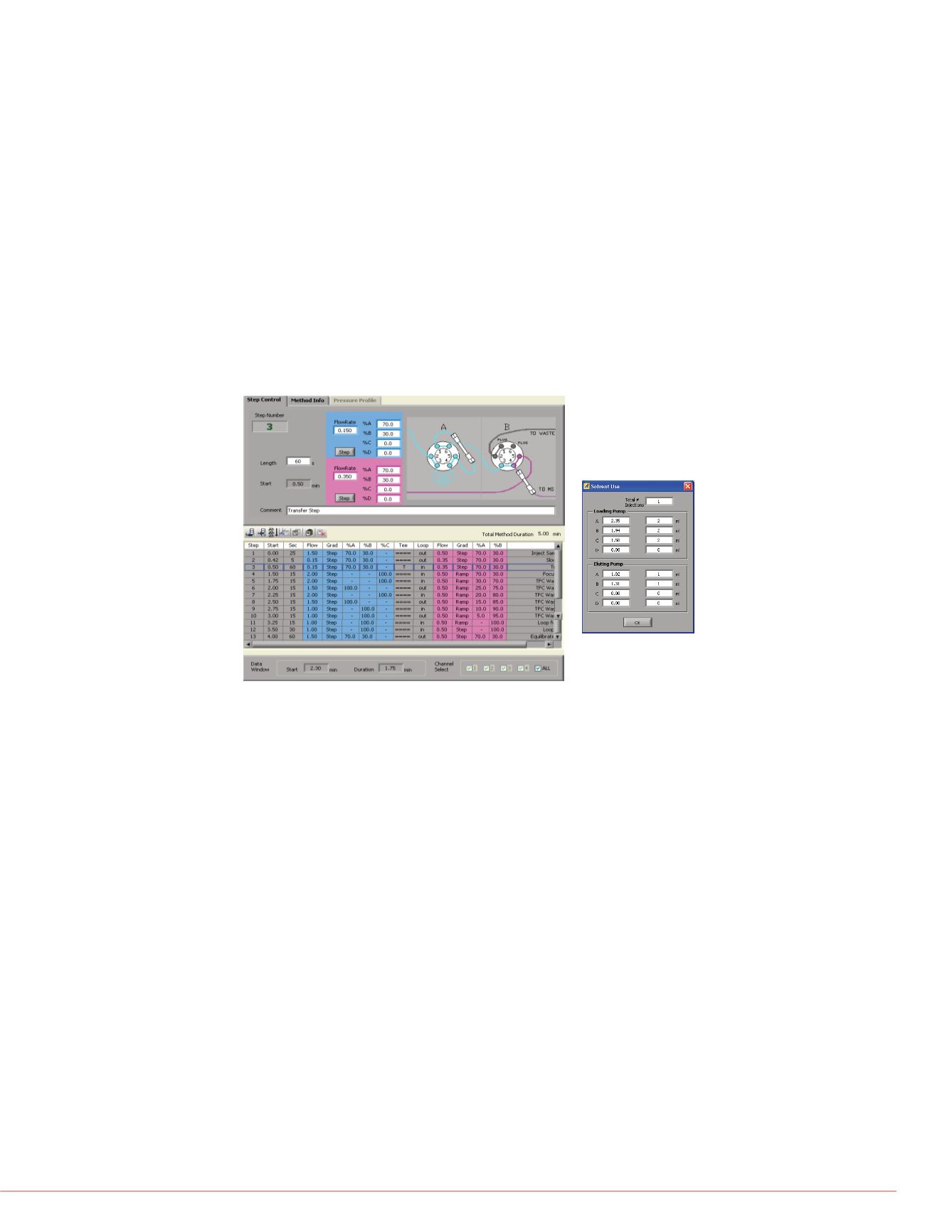

3
Thermo Scientific Poster Note
•
PN ASMS13_TP29_JDiBussolo_e 06/13S
od performance utilizing an
uid chromatography (SPLC)
whole blood when measuring
urposes by tandem mass
ion (ESI).
ed clean up of whole blood
tion by aqueous zinc sulfate and
by high-resolution liquid
µm HPLC column. Reversed-
were done in a way that avoided
ids, which would have suppressed
f four ISDs was achieved by
ards (IS).
stently reproduced within systems
d levels were reliably measured:
limus and Tacrolimus; and
. A throughput of 21 samples per
th channels, which generated only
er between samples was detected.
lyzed in whole-blood using LC-MS
nterference by phospholipids.
ble to compensate, minimizing
The Thermo Scientific™ Prelude™
t automates sample preparation
ed to the ESI of a tandem mass
he Prelude SPLC system
chnology and high-efficiency LC
vatives D
12
-Cyclosporin-A and
rds in the whole-blood sample
zed to reliably minimize
ta quality. The method was also
FIGURE 4. Optimized HPLC Condit
Elution from Accucore C8, 2.6 µ
FIGURE 3. Non-Optimized HPLC
Elution from Accucore PFP, 2.6 µ
Mass Spectrometry
The Thermo Scientific™ TSQ Vantage™ triple-stage quadrupole system with
heated electro-spray interface (HESI-II) was used to measure the transitions from
ammonium-adduct precursor ions to product ions:
Everolimus: 975.7 > 908.4
Sirolimus: 931.6 > 864.6
Tacrolimus: 821.5 > 824.4
Tacrolimus IS: 824.4 > 771.0
Cyclosporin A: 1202.8 > 425.3
Cyclosporin A IS: 1214.9
> 437.2
During method development, the elution of phospholipids and dioctylphthalate
were tracked by adding the following transitions:
Dioctylphthalate: 391 >149
Lyso-Phosphotidylcholine;16:0: 496 > 184
Lyso-Phosphotidylcholine;18:0: 524 > 184
Phosphotidylcholine;38:6: 806 > 184
Data Analysis
Thermo Scientific™ TraceFinder™ software with Aria MX was used for instrument
control, data acquisition and data processing. The internal standards (IS) shown
above were used for quantitation by stable-isotope dilution technique.
Results
Identifying the HPLC Column and
Because ISDs are as hydrophobic as
extracted and transferred to the HP
Therefore, the HPLC conditions mu
detector in a reasonable timeframe
as well as buildup of interfering co
processing many samples. Figure 3
optimized conditions, which resulte
peak areas for internal standards in
from optimized conditions, which r
reproducibility (RSDs < 10%).
Methods
Off-Line Sample Preparation
ChromSystems 6PLUS1® ISD multilevel calibrator set and MassCheck® whole-
blood controls as well as in-house test samples were mixed with aqueous zinc
sulfate solution and then with methanol containing internal standards:
Tacrolimus-
13
CD
2
(Toronto Research Chemicals, Canada) and D
12
-Cyclosporin A
(Alsachim, France). After centrifugation, supernatants were harvested into glass
autosampler vials.
On-Line Sample Preparation & Liquid Chromatography (SPLC)
In each channel, 20 µL injections of supernatants were extracted with a Thermo
Scientific™ TurboFlow™ Cyclone-P™ TurboFlow column (0.5 x 50mm) using a
mobile phase mixture of 7:3
water:methanolcontaining 10 mM ammonium
formate and 0.05% formic acid at 1.5 mL/min. A slow flow of methanol eluted
extracted ISDs, which merged with a higher flow of a 7:3 water: methanol
mixture, to transfer and focus the ISDs to an Accucore C8, 2.6 um, 3.0 x 30 mm
HPLC column, which was maintained at 70 °C by the built-in heater. The ISDs
were separated from matrix interferences and eluted to the heated electrospray
ionization (HESI) source by a gradient of increasing methanol. Figure 2 shows this
focus method.
ysed
MW:
Sirolimus
C
51
H
79
NO
13
MW: 914.17
FIGURE 2. Summary of SPLC Focus Method.
Solvents:
A:
Water + 10mM NH
4
OOCH +
0.05% HOOCH
B:
Methanol + 10mM NH
4
OOCH
+ 0.05% HOOCH
C:
45% Acetonitrile + 45%
Isopropanol + 10% Acetone
Total solvent consumption is
3.37 mL A, 3.25 mL B, 1.5 mL C
for each injection.
Dioctylphthalate:
Lyso-Phosphotidylcholine;16:0:
Lyso-Phosphotidylcholine;18:0:
Phosphotidylcholine;38:6:
.Tacro:
Siro:
Evero:
Lyso-Phosphotidylcholine;16:0:
Lyso-Phosphotidylcholine;18:0:
Phosphotidylcholine;38:6:
.Tacro:
Tacro IS:
Siro:
Evero:



















